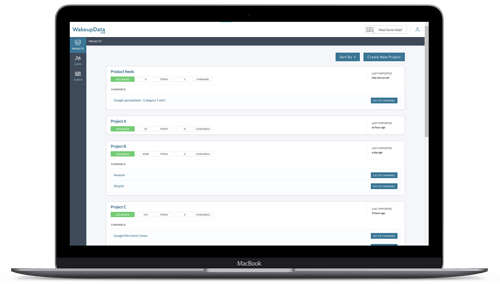Google Text Ads: Best Practices
Posted on September 15, 2021 (Last Updated: September 15, 2021)
In this blog we are looking at best practices for optimizing your Google Text Ads and have asked Anton Hoelstad, Head of Search & Partner at 1260 and Dorte Tindahl, COO & Partner at ASENTO to share some of their golden nuggets.
At WakeupData we work with a number of brilliant agencies that help their clients perform well and grow their businesses. These digital experts possess a great amount of experience and knowledge in all areas of digital advertising - and we thought we would share some of that knowledge with you.
![]()
A Comprehensive Keyword Analysis
As for any other project, it is important to start with a strong foundation. When planning your Google Text Ad campaigns it is a good idea to start with a comprehensive keyword analysis. And while you are at it, also take a look at your negative keywords to avoid spending on worthless clicks.
To make the most of your keyword analysis, make sure to follow Dorte Tindahl's Best Practices for Google Ads Keywords Analysis.
Remember your CTA’s
This is a tip you have heard way too often. But that is only because it is too important to neglect - and sometimes can seem unnecessary to waste characters on, when we are so limited already. But one thing is to be sure to use the company’s most important USP’s in the ad copy and ad extensions - another is to encourage people to do what you want them to. And you do have the option to be a bit more creative than just using the standard options such as “Read more”, “Click here”, “Buy now” etc. Customise your CTA to your company if possible. For instance, if your company is environmentally focused you could ask them to “Help us save the world today!”.
Anton Hoelstad
Head of Search & Partner @ 1260
![]()
Be local if you can
Local campaigns with geographic targeting and a local insert can be very effective. Picture a local gym ad – Wouldn’t you like to know where it’s located? If it’s even relevant for you, before even clicking the ad? A lot of businesses stretch their geo-targeting too far in the search for clients and end up getting irrelevant clicks.
Know your clients and know your strategy. How far would they travel to do business with you?
Using geo-targeting and ad scheduling, you’re able to create very specific campaigns. Even for omnichannel businesses.
If a store is open 9-17 – you’d advertise as follows:
In the proximity of the store you’d advertise from 9-16 that the store is open and ready to help you. Further away you’d go with a message for the online store. From 16-09 you’d advertise the online shop being open for your shopping needs 24/7.
Some businesses make the mistake of taking this task too lightly. It’s all about customization.
A bad example that I’ve seen is:
A chain of hotels in Denmark. Hotels in Copenhagen, Aarhus, Aalborg, and Odense.
So, this advertiser made a campaign for each of the cities – so far, so good.
But the ad groups were bundled in with each other, so a keyword “hotel close to the zoo” would be bundled in with “hotel bakken” – If you’re from Denmark, you’d know that it's a long way apart.
Even if they had a hotel in each of those areas, they should not have been in the same ad group.
The ad text was even worse – something generic like; “Come to Copenhagen and visit the sights – comfortable stay…” etc.
When visiting a hotel, or a gym, location matters – so describe your location, parking, comfort, amenities etc. Bring value to your clients.
And, add call to actions – that helps your ad score and your click rate.
Dorte Tindahl
COO & Partner @ ASENTO
Make sure you’re making money
Use a tool that helps you understand if you're making money. Companies such as Profit Metrics enables you to see, in real-time, if you're generating profit.
This enables you to make smarter decisions considering that you have different margins for different products.
Understand that not all campaigns generate profit – as they are higher in the purchase funnel – so make sure your conversion tracking is set up to give you information about contributing campaigns.
Also, there are cookie consent issues – with more than 50% saying no to being tracked (when done the proper way) – this gives your smart bidding less data to work with. Google is beta testing hashed data and enhanced conversions to bypass this.
This reporting will then also look at AI – to fill in gaps – which might lead to some over-reporting.
But when it comes to smart bidding, over-reporting is better than under-reporting.
Dorte Tindahl
COO & Partner @ ASENTO
![]()
Split-testing
We all know the importance of split-testing on our ad copies. With the the wait to crown a winner the split-test often gets neglected. Or maybe you draw the wrong conclusions.
To get the most from your split-testing, make sure to follow Anton Hoelstad's Best Practices for Google Ads Split-testing.
Avoid redundancy
Another sad thing to see when you open a Google Ads account is redundancy in the ad copy, like mentioning the same USP’s several times in the same ad. This can be in both the actual ad copy (one headline and one description line using the same arguments) - or the combination between ad copy and ad extensions.
I often see ad extensions using the exact same (or close to) USP used in the ad copy (normally one of the headlines). This is just a waste of characters that could be used for something else (and much better). It is easy to spot if you see the actual ad in the SERPs (Search Engine Result Page), but experience shows that not enough people try to make this test themselves.
Anton Hoelstad
Head of Search & Partner @ 1260
Create responsive ads
Come June 2022 the option to create and correct expanded text ads (ETAs) will be cancelled.
It has long been a part of an unspoken plan to cancel the ETAs – If you have used the interface for ad creation in the last year you would have been blind to not see their agenda – You would have had to shift from a responsive text ad (RTAs) to an ETA – Making life difficult for those who want to control their ads better.
Although control was an illusion even with ETAs. You never knew if the third headline or the second description would be shown – or if Google would cut it in a weird place.
So, RTAs are taking over the world.
It was announced not too long ago – and now for the best part.
If you want a better ad strength (which Google says will help your CTR and therefore your Quality score, prices etc) you need to let Google decide which headlines and descriptions to use.
You could pin certain headlines and descriptions into a specific position – but that leaves Google AI with less options to create the perfect ad – and therefore a lesser ad strength for you.
Google should use the most relevant headlines and descriptions for your ads, but this also means that you need to factor this in, when creating your ad copy.
You need to choose at least 8 headlines (max 15) and 2 descriptions (max 4)
At ASENTO we would use 10-15 headlines depending on the USP’s available plus call to actions. For descriptions we usually use all 4. All the best practices that you know from way back when a text ad was just a text ad, are still in play.
Because you give Google the option to put the ad text together with AI, make sure that the same text isn’t just being said in another way – e.g., free shipping, free delivery, 0 cost delivery etc.
Make sure to have clear call to actions and special offers in the ad text to get that click.
Dorte Tindahl
COO & Partner @ ASENTO
![]()
Create extensions whenever it makes sense
Any extensions from sitelink to image extensions are important. Even a lead form or other extensions that aren’t widely clicked.
They all contribute to higher click rates and help the person searching to understand your business and your product.
Image extensions are fairly new, and not widely used – but the first learnings from our clients at ASENTO are that it does impact your click rates to have a visual image in the search ad.
When diving into the numbers, we can see that when the image extensions are shown together with the search ad, the click rate is higher.
Which makes sense. It was tested with text ads in the image search fields – where you could upload 2-4 images per ad group – this was in 2012 – we saw great results back then, but I guess the world wasn’t ready until now.
Another very important extension is the sitelink extension. This might just be the best one you could improve your ad with.
Other than pleasing Google this offers you the chance to create more inventory on the SERP – but also a shortcut for the person searching. A shortcut to your contact page, your best-selling product within the campaign etc.
Remember to associate the sitelink on a campaign level to maintain a little control on what is shown with what campaign.
Dorte Tindahl
COO & Partner @ ASENTO



